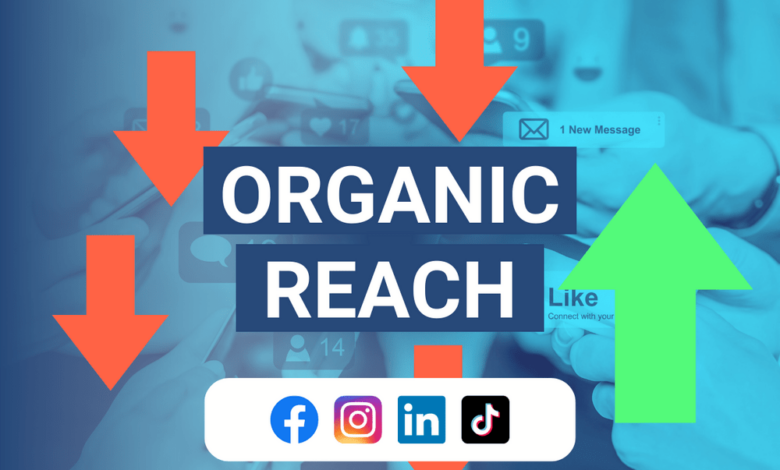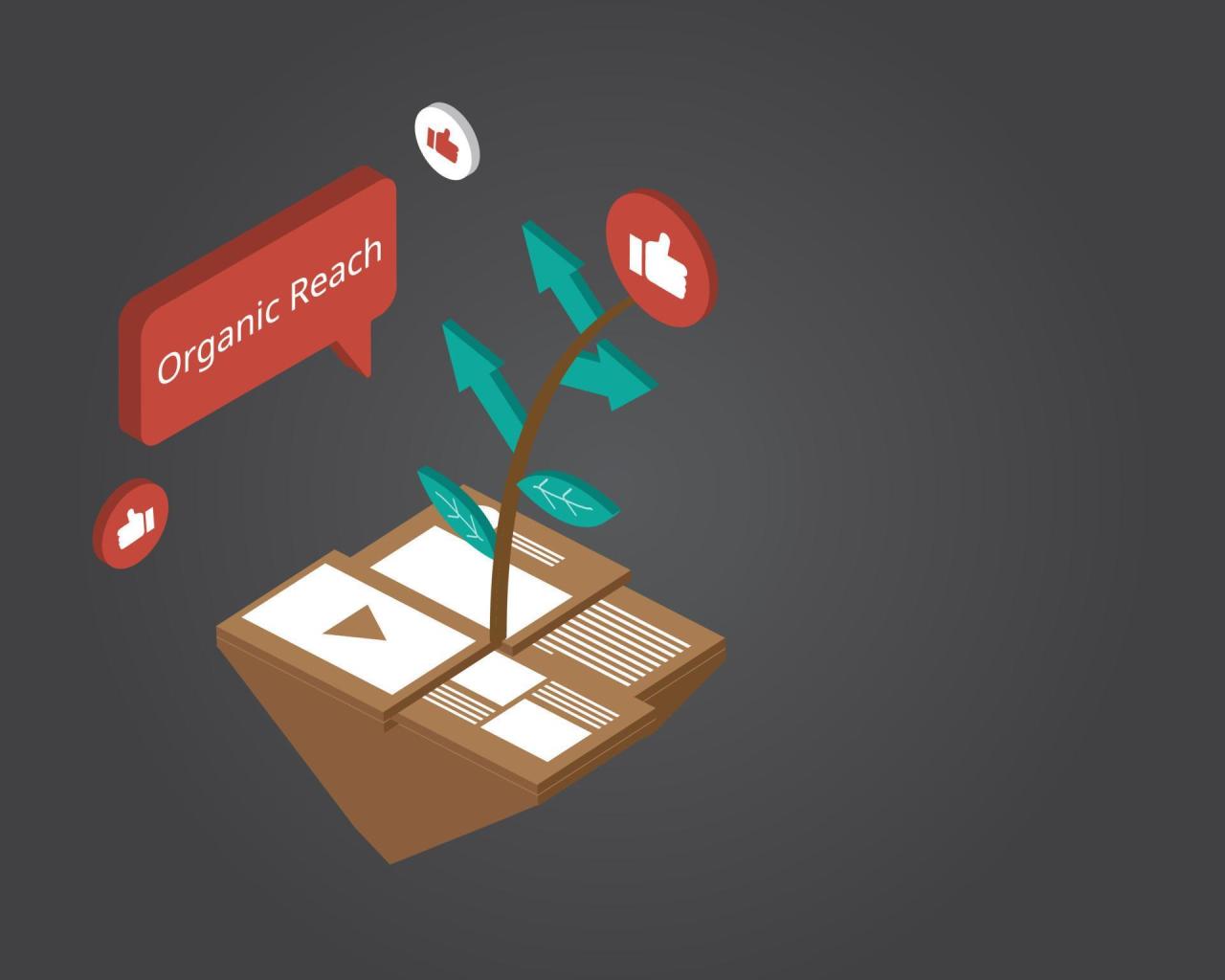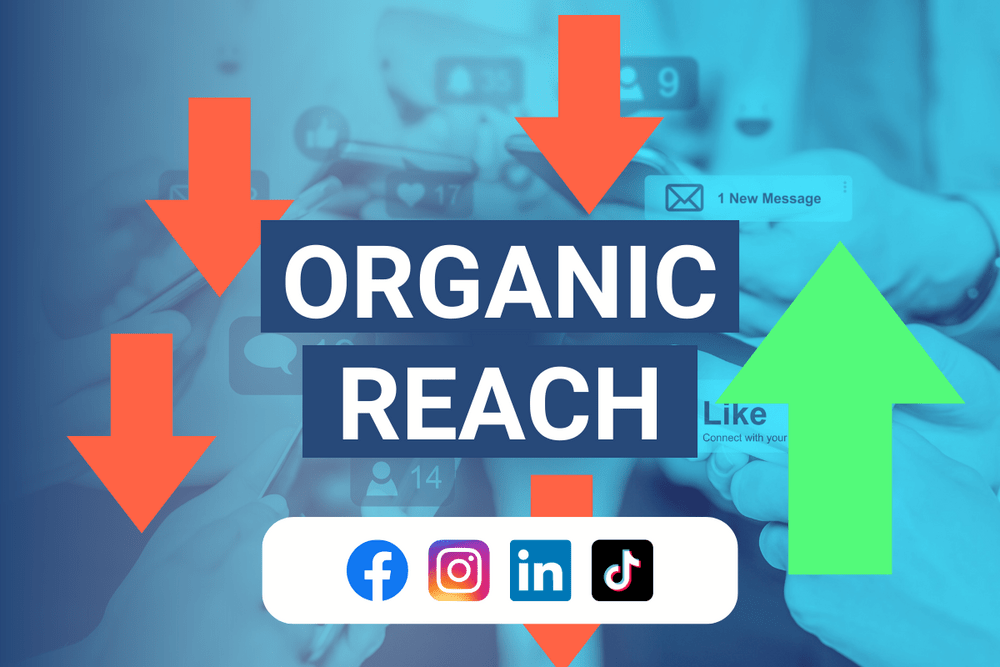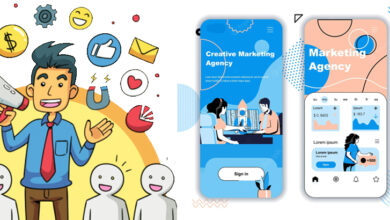
Organic Reach Marketing Explained Your Guide
Organic reach marketing explained sets the stage for understanding how to build a strong online presence without relying on paid advertising. It dives into the nuances of attracting an audience naturally, focusing on strategies that can generate significant visibility and engagement across various social media platforms. From crafting compelling content to fostering a vibrant online community, this exploration will unveil the secrets to achieving high organic reach.
This comprehensive guide will delve into the key elements of organic reach marketing, examining how to maximize your visibility without spending a dime on ads. We’ll explore the specific strategies for each platform, analyze successful case studies, and uncover the secrets to keeping your content relevant and engaging in a constantly evolving digital landscape. Understanding these strategies is crucial for businesses looking to establish a strong online presence without relying solely on paid promotion.
Defining Organic Reach Marketing
Organic reach marketing focuses on attracting and engaging audiences without relying on paid advertising. It leverages various strategies to increase visibility and build a loyal following, often resulting in a more sustainable and cost-effective approach to long-term growth compared to paid methods. This approach emphasizes building genuine connections and providing valuable content that resonates with the target audience.Organic reach marketing differs significantly from paid marketing, which involves direct investment to achieve specific visibility targets.
Organic strategies build a foundation of trust and reputation over time, while paid strategies often offer immediate, but potentially less enduring, results. Organic methods emphasize consistency and high-quality content, while paid methods often involve more targeted campaigns with specific goals.
Key Differences Between Organic and Paid Marketing
Organic marketing emphasizes building a strong online presence through consistent, valuable content. This approach is built on trust, community engagement, and search engine optimization. Paid marketing, on the other hand, leverages paid advertisements to immediately reach a wider audience. While paid strategies can drive quick results, they often require a continuous investment.
Core Principles of Effective Organic Reach Strategies
Effective organic reach strategies hinge on a few crucial principles. First, quality content creation is paramount. Compelling, informative, and engaging content is key to attracting and retaining users. Second, consistent posting is essential for maintaining audience engagement. Regular content updates keep the audience engaged and remind them of your brand.
Third, audience engagement is vital. Responding to comments, fostering discussions, and creating interactive content cultivates a loyal following. Fourth, search engine optimization () plays a critical role in improving visibility. Optimized content increases the likelihood of appearing in relevant search results, boosting organic traffic.
Industries Reliant on Organic Reach Marketing
Several industries heavily rely on organic reach strategies to build brand awareness and cultivate customer loyalty. For instance, content marketing businesses, influencer marketing agencies, and e-commerce platforms heavily rely on organic reach to showcase their products and services. These strategies help build a strong brand image and cultivate trust among customers, especially in competitive markets.
Comparison of Organic and Paid Social Media Strategies
| Feature | Organic Social Media | Paid Social Media |
|---|---|---|
| Cost | Low (primarily time investment) | High (requires budget allocation) |
| Control | Limited (dependent on platform algorithms) | High (can target specific demographics, interests, etc.) |
| Reach | Potentially wider, but slower | Immediate and targeted, but limited by budget |
Organic social media strategies focus on building a community and driving engagement through valuable content. Paid social media strategies, on the other hand, use targeted advertising to reach specific demographics, increasing visibility. The choice between organic and paid depends on the specific goals and resources of the business.
Understanding Organic Reach on Different Platforms

Organic reach on social media is the number of unique users who see your content without paying for advertising. It’s a crucial metric for understanding the true potential of your social media presence and for gauging how effectively your content resonates with your audience. Understanding how organic reach works on different platforms is key to maximizing your efforts and achieving meaningful engagement.Organic reach is influenced by several factors, including algorithm changes, audience engagement, and the type of content shared.
Organic reach marketing explained boils down to attracting eyeballs without paying for ads. A key part of that is understanding how to craft a social media posting schedule that truly resonates with your audience. Learning how to make a social media posting schedule, for example, will allow you to strategically place your content where it’s most likely to be seen by your ideal customers how to make a social media posting schedule.
This, in turn, maximizes your organic reach and makes your marketing efforts far more effective.
Each platform has its own algorithm that prioritizes different aspects of a post, from its visual appeal to the level of interaction it generates. This necessitates tailored strategies to optimize visibility on each platform.
Organic Reach on Facebook
Facebook’s algorithm prioritizes content that fosters meaningful interactions. Posts that encourage comments, shares, and reactions are more likely to be seen by a wider audience. High-quality visuals, engaging captions, and timely posting are crucial for maximizing organic reach. Content related to current events, local interests, and personal connections tends to perform well. Furthermore, Facebook groups and targeted posting can significantly impact visibility.
Organic Reach on Instagram
Instagram’s algorithm heavily favors visually appealing content. High-quality images and videos, consistent posting schedules, and engaging captions are essential. Stories, Reels, and live videos can significantly boost visibility. User-generated content, influencer collaborations, and relevant hashtags play a critical role in increasing organic reach.
Organic Reach on Twitter
Twitter’s algorithm prioritizes real-time conversations and trending topics. Sharing insightful commentary, engaging in relevant discussions, and using relevant hashtags are key strategies. Content that is timely and relevant to current events or trends tends to perform better. Engaging with other users through replies and retweets can expand your reach significantly.
Comparison of Organic Reach Strategies, Organic reach marketing explained
While the fundamental principle of engagement remains consistent across platforms, the specific strategies for maximizing organic reach vary. Facebook prioritizes interactions, Instagram focuses on visual appeal, and Twitter relies on real-time engagement and trending topics. A comprehensive strategy should consider the unique characteristics of each platform to optimize visibility and engagement.
Platform-Specific Organic Reach Best Practices
| Platform | Best Practices |
|---|---|
| High-quality visuals, engaging captions, timely posting, Facebook groups, targeted posting | |
| High-quality images/videos, consistent posting schedule, engaging captions, Stories/Reels/live videos, user-generated content, influencer collaborations, relevant hashtags | |
| Insightful commentary, engaging in relevant discussions, using relevant hashtags, timely content, engaging with other users |
Content Strategy for Organic Reach

Organic reach marketing isn’t just about posting; it’s about strategically crafting a content calendar and consistently delivering engaging content that resonates with your target audience. A well-defined content strategy is crucial for building a loyal following and achieving sustainable growth. It’s a long-term investment that requires careful planning and consistent execution.A strong content strategy fosters brand awareness, drives traffic to your website, and ultimately converts prospects into customers.
It’s the engine that fuels your organic growth, allowing you to connect with potential clients in a meaningful way.
Consistent Content Calendar
A well-structured content calendar is paramount for organic reach. It acts as a roadmap, ensuring a consistent flow of valuable content to your audience. Without a calendar, your efforts can feel sporadic and less impactful.
- Regular posting schedules, whether daily, weekly, or bi-weekly, are crucial for maintaining audience engagement. Consistency builds anticipation and keeps your brand top-of-mind.
- Planning ahead allows for theme-based content, offering a structured approach to creating relevant posts. This method allows for a more cohesive and impactful campaign.
- Scheduling tools can automate your posting process, freeing up your time for more strategic tasks and allowing you to focus on content creation.
Engaging Content Formats
Content formats need to be tailored to capture and maintain audience interest. Different formats cater to different preferences and consumption habits.
- Blog posts provide in-depth information and establish you as an authority in your niche. Combining written content with high-quality visuals makes it more engaging.
- Videos are exceptionally effective for conveying information and fostering emotional connections. Short, engaging videos are highly shareable and easily digestible.
- Interactive content, such as polls, quizzes, and surveys, fosters audience participation and creates a sense of community.
- Infographics and other visual representations of data condense complex information into easily digestible formats, perfect for social media.
High-Quality Visuals and Videos
High-quality visuals and videos are crucial for capturing attention and driving engagement. They enhance the overall aesthetic and increase the memorability of your content.
- Visually appealing images and videos that align with your brand’s identity enhance the aesthetic appeal of your posts.
- Visual content, such as images and videos, should be relevant to the topic and add value to the post.
- High-resolution images and videos enhance the overall quality of your content, making it more professional and trustworthy.
- Using relevant visuals can make a complex topic easier to understand, improving the clarity of your message.
Successful Content Strategies in Various Industries
Different industries can leverage different content strategies to achieve optimal organic reach.
- Fashion brands often employ visually-driven content, showcasing their latest collections through high-quality photos and videos.
- Tech companies can use blog posts and videos to explain complex topics, demonstrating their expertise and building trust.
- Food bloggers can create engaging recipes, delicious food photography, and behind-the-scenes videos to connect with their audience.
- Fitness influencers can utilize videos and images to inspire and motivate their followers.
Fictional Business Content Strategy Template
Let’s consider “Cozy Corner,” a fictional online retailer specializing in handcrafted home decor. Their target audience is environmentally conscious individuals interested in unique, stylish pieces.
| Week | Topic | Content Format | Platform | Target Audience Engagement |
|---|---|---|---|---|
| 1 | Sustainable Home Decor | Blog post, infographic | Instagram, Facebook | Encourage comments and shares on the sustainability aspect |
| 2 | New Collection Launch | Video showcasing new pieces, product photos | Instagram, Pinterest | Drive traffic to the website and highlight unique designs |
| 3 | DIY Home Decor Ideas | Blog post, step-by-step photos | Facebook, Pinterest | Promote engagement through DIY instructions |
| 4 | Customer Stories | Short videos featuring customers’ spaces | Instagram, TikTok | Highlight customer satisfaction and inspire others |
Audience Engagement and Community Building
Organic reach isn’t just about creating great content; it’s about fostering a community around it. Active engagement with your audience builds trust, loyalty, and ultimately, a stronger, more visible presence online. This interaction goes beyond simple likes and comments; it’s about creating meaningful connections that keep your audience coming back for more.Engaging with your audience is crucial for driving organic reach.
When followers feel heard and valued, they’re more likely to share your content, recommend you to others, and become brand advocates. This positive feedback loop is vital for long-term organic growth. A thriving online community fosters a sense of belonging, encouraging consistent interaction and organic growth.
The Role of Audience Interaction
Audience interaction isn’t just a nice-to-have; it’s a necessity for organic reach. Direct interaction, including responding to comments and questions, fosters a sense of community and encourages further participation. By actively listening and engaging, you build a relationship with your audience that extends beyond a simple transaction. When people feel valued, they are more likely to become loyal followers and advocates.
They’re also more likely to share your content with their networks, thus amplifying your message organically.
Importance of Community Building
Building a community around your brand is essential for sustainable organic reach. A community isn’t just a collection of followers; it’s a group of engaged individuals who share interests and values. By facilitating conversations and fostering a sense of belonging, you create a loyal following that actively supports your brand. This supportive network becomes a powerful amplifier for your organic reach.
Successful communities provide a platform for users to connect with each other, fostering loyalty and organic growth.
Methods for Fostering Engagement
Consistent engagement with followers is key to maintaining organic reach. Here are some effective methods for creating an active and engaged community:
- Responding to Comments and Messages: Promptly responding to comments and messages demonstrates that you value your audience’s input. This fosters a sense of connection and encourages further interaction.
- Creating Interactive Content: Interactive content, such as polls, quizzes, and Q&A sessions, encourages participation and keeps your audience engaged.
- Running Contests and Giveaways: Contests and giveaways are effective engagement tactics, driving excitement and encouraging participation.
- Hosting Live Sessions: Live sessions, such as Q&A sessions or product demos, provide an opportunity for direct interaction and build a stronger connection with your audience.
- Collaborating with Influencers: Collaborating with relevant influencers can introduce your brand to a wider audience and foster engagement.
These methods are not merely ways to increase engagement but rather crucial steps toward building a genuine and thriving community.
Examples of Successful Community Management Strategies
Several brands have effectively leveraged community management strategies to drive organic reach. For example, successful brands frequently use social listening tools to track conversations about their brand and respond accordingly. They also encourage user-generated content by featuring customer creations on their platforms. Successful community management is a two-way street, and these brands understand the importance of actively participating in the conversations surrounding their brands.
Understanding organic reach marketing is key to growing your online presence. It’s about getting your content seen without paying for ads, and that’s where a deeper dive into trends like TikTok’s For You Page comes in. To really grasp the power of these trends, check out our guide on fyp for you page marketing explained. Ultimately, organic reach marketing hinges on creating engaging content that resonates with your target audience, regardless of the platform.
“Community management is not about broadcasting; it’s about listening, responding, and building relationships.”
Engagement Tactics and Impact
The table below Artikels different engagement tactics and their potential impact on organic reach.
| Engagement Tactic | Potential Impact on Organic Reach |
|---|---|
| Responding to comments and messages | Increased follower engagement, fostering a sense of community. |
| Creating interactive content (polls, quizzes) | Higher user interaction, increased content visibility. |
| Running contests and giveaways | Increased brand awareness, heightened engagement. |
| Hosting live sessions (Q&As, product demos) | Enhanced audience connection, stronger brand loyalty. |
| Collaborating with influencers | Exposure to a wider audience, increased credibility. |
These tactics are proven strategies to engage your audience, building a loyal community and significantly increasing organic reach.
Measuring and Optimizing Organic Reach
Organic reach is about visibility without paid promotion. Understanding how to measure and optimize this visibility is crucial for sustained growth. Success in organic reach hinges on analyzing performance data, identifying weaknesses, and implementing adjustments. By tracking key metrics and iterating based on results, businesses can fine-tune their strategy for maximum impact.
Key Metrics for Tracking Organic Reach
Understanding the metrics that drive organic reach is fundamental to optimization. These metrics provide insights into the effectiveness of content and the engagement of the audience. Key metrics include:
- Impressions: The number of times your content was shown to users. A high number of impressions indicates broad visibility, but it’s not the only factor to consider. The quality of impressions, or how relevant they are to your target audience, is just as important.
- Reach: The number of unique users who saw your content. This is a direct measure of audience exposure. High reach suggests your content is getting in front of the right people.
- Engagement Rate: This encompasses actions like likes, shares, comments, saves, and clicks. A high engagement rate indicates that your content resonates with the audience and encourages interaction. A low engagement rate might signal a need to refine content style, topic, or posting schedule.
- Click-Through Rate (CTR): The percentage of users who saw your content and clicked on it. This metric reveals how compelling your content is at driving desired actions. A high CTR suggests your content is effectively capturing interest and leading to further engagement.
- Website Traffic: The number of users who visited your website from your organic social media posts. This is a direct indicator of the success of your organic reach strategy in driving traffic to your site.
Analyzing Data to Identify Areas for Improvement
Regular analysis of collected data is essential for identifying patterns and trends. These insights can then be used to refine your strategy and improve results. For instance, if you notice a high number of impressions but low engagement, it might indicate that your content isn’t tailored to the interests of your target audience. Conversely, a high engagement rate but low reach might signal the need to expand your social media presence or optimize your posting schedule.
Significance of A/B Testing in Optimizing Organic Reach
A/B testing is a valuable tool in optimizing organic reach. It allows you to compare two versions of a piece of content to determine which performs better. This is crucial for discovering what resonates most effectively with your audience. By testing different headlines, images, calls to action, or even posting times, you can gain insights into what drives the most engagement.
For example, you could test two different versions of a Facebook post to see which one generates more likes or shares. The version that performs better can then be used in future posts.
Organic reach marketing explained boils down to getting your content seen by more people without paying for ads. Want to boost your visibility naturally? Checking out these 10 social media tips for small businesses to save time 10 social media tips for small businesses to save time can be a great starting point. These time-saving strategies will help you focus on creating engaging content that resonates with your target audience, ultimately improving your organic reach.
Examples of Tools for Tracking and Analyzing Organic Reach Performance
Numerous tools are available to help track and analyze organic reach performance. Choosing the right tool depends on your specific needs and budget.
| Tool | Description |
|---|---|
| Google Analytics | Provides comprehensive website analytics, including traffic sources from social media. |
| Hootsuite | Offers social media management tools, allowing you to track key metrics across various platforms. |
| Buffer | Provides scheduling and analytics features, enabling you to monitor the performance of your posts. |
| Sprout Social | Offers social listening and engagement tools, providing detailed insights into audience interactions. |
| Socialbakers | Focuses on social media analytics, providing a comprehensive view of performance across various platforms. |
Staying Up-to-Date with Algorithm Changes
Keeping your organic reach marketing strategy effective requires constant vigilance. Social media algorithms are in constant flux, evolving to improve user experience and engagement. Understanding these changes and adapting your approach is crucial for sustained success. Failure to do so can lead to a significant drop in visibility and reduced impact of your content.Algorithm updates across different platforms often aim to prioritize high-quality, engaging content that resonates with users.
This means focusing on authenticity, user interaction, and relevance to the target audience. A proactive approach to staying informed about algorithm shifts and a willingness to adjust strategies accordingly is vital for maintaining a strong organic presence.
Frequency of Algorithm Updates
Social media platforms constantly refine their algorithms to enhance user experience and ensure the delivery of relevant content. This process often involves minor adjustments and significant overhauls, aimed at improving user engagement and content discovery. The frequency of these updates varies by platform, but they are frequent enough to warrant a proactive monitoring approach. Platforms like Facebook, Instagram, and Twitter frequently release algorithm updates, sometimes introducing new ranking factors, adjusting weighting for various content types, and altering the order in which posts appear in users’ feeds.
Impact of Algorithm Changes on Organic Reach
Algorithm changes directly affect organic reach. Changes can result in fluctuations in visibility, with some content receiving a significant boost while others experience a considerable drop. Content that aligns with platform goals, including quality, engagement, and user experience, generally sees an increase in visibility. Conversely, content that doesn’t meet the updated criteria may experience reduced visibility or even complete suppression from the feed.
The impact is often not uniform across all accounts; some might see minor adjustments, while others may encounter more drastic changes in their organic reach.
Adapting to Algorithm Updates in Marketing Strategies
A proactive approach to adapting marketing strategies to algorithm updates is essential. This requires a combination of ongoing monitoring, a flexible mindset, and a willingness to experiment. Regularly review your content performance and adjust your content strategy based on insights. Analyzing what performs well on the platform and how user engagement is affected by content type is crucial.
Adapting to changes means shifting from a rigid schedule to a more dynamic approach to content creation.
Examples of Successful Adaptation to Algorithm Changes
Numerous brands have successfully adapted to algorithm updates. For example, a clothing retailer might have noticed that user engagement with videos was rising. They adapted their strategy by creating more engaging video content showcasing their products. This shift allowed them to maintain and even improve their organic reach. Another example is a travel agency, recognizing that user interaction with high-quality images and detailed descriptions was increasing.
They focused on producing more visually appealing content, which helped them increase their organic reach.
Staying Informed About Algorithm Changes on Social Media
Staying informed about algorithm changes on social media requires a multi-faceted approach. Follow official platform announcements, reputable social media marketing blogs, and industry experts. Keep a close eye on data analytics tools that provide insights into algorithm trends. Use these resources to understand the nuances of platform updates and identify any patterns in content performance. Monitoring industry trends, analyzing competitor strategies, and paying attention to changes in user behavior can provide invaluable insights.
Case Studies of Successful Organic Reach Campaigns: Organic Reach Marketing Explained
Organic reach, the ability to attract attention and engagement without paid advertising, is a powerful tool for businesses seeking sustainable growth. Successful organic campaigns demonstrate the effectiveness of strong content strategies, consistent engagement, and a deep understanding of target audiences. These campaigns highlight how businesses can build genuine connections and achieve significant visibility without relying on external boosts.
Examples of Successful Organic Reach Strategies
Several businesses have achieved remarkable organic reach, showcasing effective strategies that can be replicated and adapted. These campaigns highlight the importance of creating valuable content that resonates with the target audience and actively engaging with them.
- Content Marketing as a Cornerstone: Many successful campaigns center around consistently producing high-quality content. For instance, a food blog might publish engaging recipes, behind-the-scenes glimpses into the kitchen, and interviews with chefs. This approach attracts a loyal readership and builds a strong brand presence. The blog’s content naturally attracts organic traffic through search engine optimization (), social media sharing, and word-of-mouth.
- Community Building Through Engagement: Companies often cultivate online communities through interactive content formats. A fitness brand might host live workout sessions on Instagram, encourage user-generated content through challenges, and actively respond to comments and messages. This creates a sense of belonging and fosters brand loyalty.
- Leveraging User-Generated Content (UGC): Encouraging customers to share their experiences and opinions can be highly effective. A clothing retailer might run a contest where customers share photos of themselves wearing their products, with the winners featured on the brand’s social media channels. This tactic promotes brand visibility and authentic storytelling.
Analysis of Strategies in Successful Campaigns
Analyzing the strategies employed in successful campaigns reveals key patterns and actionable insights. These patterns often involve a combination of factors, including a deep understanding of the target audience, a clear content strategy, and a consistent engagement plan.
- Targeted Content Creation: Successful campaigns prioritize creating content that addresses the specific needs and interests of their target audience. A sustainable living brand, for example, might produce articles on eco-friendly practices, sustainable fashion, and zero-waste living.
- Consistent Posting Schedule: Regular and consistent content posting keeps the audience engaged and builds anticipation for new content. A technology blog might publish new articles or updates every week, ensuring a steady stream of information for its readers.
- Active Audience Engagement: Businesses that foster two-way communication with their audience are more likely to see success. A travel company might engage with followers by asking questions, responding to comments, and hosting polls about upcoming destinations.
Diverse Industry Examples
Successful organic reach campaigns span various industries. Below are examples from different sectors:
- Fashion: A fashion brand could generate organic reach through high-quality product photography, behind-the-scenes content showcasing the design process, and engaging with fashion influencers. This approach builds a visual brand story that resonates with followers.
- Technology: A tech company might create informative blog posts about industry trends, host webinars or online workshops, and share insightful articles on social media platforms.
- Food and Beverage: A food blogger might produce engaging recipes, showcase the preparation process, and create videos demonstrating culinary techniques. This approach attracts viewers interested in cooking and food trends.
Key Takeaways from Case Studies
| Aspect | Key Takeaway |
|---|---|
| Content Quality | High-quality, engaging content is crucial for attracting and retaining a dedicated audience. |
| Audience Engagement | Active engagement with the audience through interactions, responses, and community building is vital for organic reach. |
| Consistency | Regular and consistent posting keeps the audience engaged and builds anticipation. |
| Platform Optimization | Understanding and optimizing content for each platform (e.g., Instagram, Twitter, Facebook) is essential. |
Final Review
In conclusion, organic reach marketing explained the importance of a multifaceted approach. Building a loyal audience through engaging content, active community management, and consistent optimization are all essential components for long-term success. Understanding the nuances of each platform’s algorithms and adapting to frequent changes are crucial for sustained organic growth. By implementing the strategies discussed in this guide, businesses can effectively reach their target audience and establish a robust online presence without costly paid advertising.




